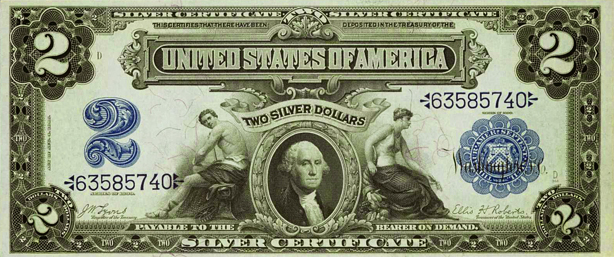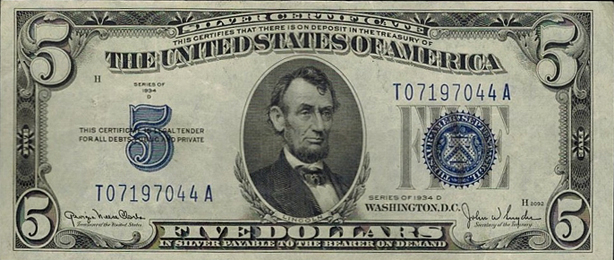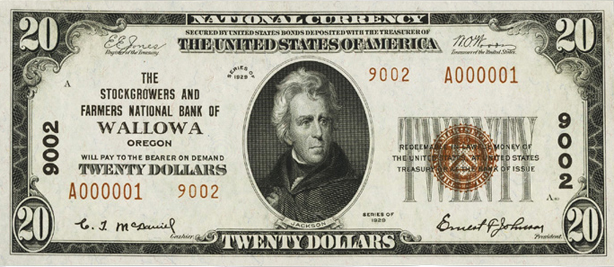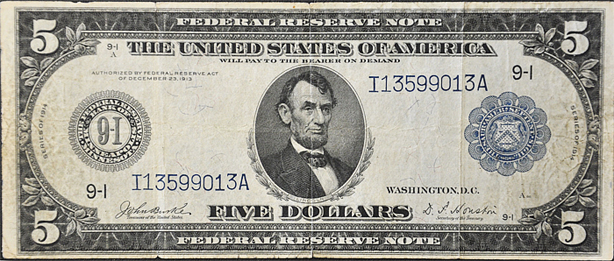
|

|

|

|

|
english version below
http://www.sjsu.edu/faculty/watkins/BofUS.htm
La prima banca degli Stati Uniti 1791-1811
La Repubblica americana aveva notevoli problemi finanziari nei suoi primi giorni. La prima banca americana era stata organizzata da Robert Morris nel 1781. Questa era una banca privata, ma contribuì a finanziare la guerra rivoluzionaria, che non finì fino al 1783. Alexander Hamilton, uno dei principali innovatori organizzativi della Repubblica, sosteneva la creazione di un banca centrale, banca dei banchieri che sarebbero stati i prestatori di ultima istanza. Tale banca centrale avrebbe stabilizzato il sistema finanziario ed emettesso banconote per integrare l'oro e l'argento in circolazione. Hamilton vedeva i fondi di prestito al governo federale come un’importante funzione della banca centrale. Hamilton propose la creazione di una banca nazionale per gli Stati Uniti e un disegno di legge fu introdotto al Congresso per realizzare la proposta di Hamilton. C'era grande opposizione al disegno di legge sulla base del fatto che la creazione di tale banca con il monopolio dell’emissione di moneta era incostituzionale. La proposta di Hamilton che era stata approvata e convertita in legge nel 1791, forniva solo un Contratto di 20 anni per la Banca degli Stati Uniti. Il Contratto avrebbe dovuto essere rinnovato nel 1811.
La Banca degli Stati Uniti risolse molti dei problemi monetari che turbavano il paese prima del 1791. Ma la Banca degli Stati Uniti era un istituto privato e compratori stranieri ne acquistarono le quote di proprietà fino al 70 per cento. Questo era preoccupante per i politici americani, ma questa elevata quota di proprietà straniera non era insolita nel sistema finanziario americano. Per qualche tempo la Gran Bretagna forniva il capitale per l'economia degli Stati Uniti. Ma queste preoccupazioni e la politica, nel 1811, determinarono una votazione quasi alla pari per il disegno di legge di rinnovo del Contratto. Alla Camera dei rappresentanti il ??voto si chiuse 65 a 64 per rinviare a tempo indeterminato il rinnovo. Al Senato il voto fu di 17 a 17 parità che permise al Vice Presidente di emettere il voto decisivo. Il Vice Presidente, George Clinton, votò contro il rinnovo dello statuto della banca.
La guerra del 1812 fece emergere tutta la debolezza del sistema finanziario americano così nel 1816 si dovette rivotare lo statuto della Banca degli Stati Uniti. Il supporto per la seconda Banca degli Stati Uniti venne da figure politiche come il presidente James Monroe e il senatore John C. Calhoun, che erano preoccupati del basso livello di credito e di solvibilità finanziaria del governo federale, come rivelano le difficoltà di finanziamento dei costi della guerra del 1812. Il sostegno arrivò anche da imprenditori come John Jacob Astor, che erano preoccupati per il caos finanziario del tempo.
La seconda Banca degli Stati Uniti Il Contratto richiedeva un aumento di capitale per di 35 milioni di dollari, di cui 7 milioni erano destinati ad essere forniti dal governo degli Stati Uniti. La Banca era controllata dal Consiglio Direttivo composto da una ventina di direttori, 15 eletti dagli azionisti privati ??e 5 nominati dal Presidente degli Stati Uniti. La Banca doveva di pagare al governo degli Stati Uniti 1.5 milioni di dollari all'anno per la licenza.
Alcuni personaggi politici, per esempio Daniel Webster e John Randolph, si opponevano a questa mescolanza di potere privato e pubblico, ma la legge del Congresso era stata approvata e il presidente Monroe l’aveva firmata e convertita in legge il 10 aprile 1816. Ma il contratto era stato nuovamente limitato a venti anni. Il primo presidente della Seconda Banca fu William Jones. Jones era stato Segretario della Marina e successivamente Vice Segretario del Tesoro durante la guerra del 1812. Il suo incarico di Segretario del Tesoro era caratterizzato da una cattiva gestione delle finanze e non c'era motivo di credere che sarebbe stato più preparato a gestire la banca degli Stati Uniti.
Sotto Jones la Banca aprì filiali in molte altre città ed estese le operazioni. E’ importante notare che, mentre la Banca degli Stati Uniti funzionava come una banca centrale per gli Stati Uniti era anche una banca commerciale coinvolta nel fare prestiti. Altre banche risentirono della concorrenza di questa istituzione sostenuta federalmente. Che sottraeva loro affari. Due governi statali cercarono di vietare la costituzione di filiali della Banca degli Stati Uniti nei loro stati e altri sei cercarono di imporre tasse proibitive su queste filiali per scoraggiare il loro funzionamento. Ci sono voluti una sentenza della Corte Suprema degli Stati Uniti per evitare che queste restrizioni imposte sulla Banca degli Stati Uniti. Il capo della Giustizia, John Marshall, nel 1819 stabilì che la Banca degli Stati Uniti era uno strumento adeguato e necessario del Governo degli Stati Uniti per lo svolgimento delle proprie operazioni fiscali. Si può vedere chiaramente la perplessità di mescolare istituzioni pubbliche e private. La Banca degli Stati Uniti avrebbe anche potuto essere uno strumento necessario per le operazioni fiscali del governo degli Stati Uniti, ma era anche una banca commerciale privata.
Le succursali della Seconda Banca non erano strettamente controllati dalla principale istituzione di Philadelphia e il ramo di Baltimora venne messa sotto il controllo degli individui che la saccheggiarono per milioni di dollari prima di essere catturati. La filiale di Baltimora andò in amministrazione controllata e tutta la banca era vicina al fallimento.
William Jones si dimise nel gennaio del 1819. La presidenza della Seconda Banca degli Stati Uniti andò a Langdon Cheves della Carolina del Sud. Cheves tagliò le operazioni, riducendo i prestiti bancari da 41 milioni di dollari a 31 milioni e tagliò la quantità di banconote in circolazione da 8 milioni a 3,5 milioni. Le politiche di Cheves portarono stabilità nella seconda banca ma non senza critiche. Gli azionisti privati ??risentivano della riduzione dei dividendi. Le banche private che criticavano l'espansione della seconda Banca inoltre, criticava la sua contrazione a causa della riduzione del credito messo a repentaglio dalle insolvenze di alcune aziende che erano anche debitrici di quelle stesse banche private. Nel 1923 si dimise Cheves e Nicholas Biddle di Filadelfia divenne presidente.
http://www.sjsu.edu/faculty/watkins/BofUS.htm
The First Bank of the United States 1791-1811
The American Republic had considerable financial problems in its early days. The first American bank was organized by Robert Morris in 1781. This was a private bank but it helped in financing the Revolutionary War, which did not end until 1783. Alexander Hamilton, a major organizational innovator in the Republic, argued for the creation of a central bank, a bankers' bank which would be the lender of last resort. Such a central bank would stabilize the financial system and issue banknotes to supplement the gold and silver in circulation. Hamilton saw lending funds to the Federal Government as a major function of such a central bank. Shortly after Hamilton proposed the creation of a National Bank for the U.S. a bill was introduced into Congress to accomplish Hamilton's proposal. There was major opposition to the bill on the grounds that creation of such a bank with a monopoly on issuing money was unconstitutional. The bill passed and was signed into law in 1791 but it provided only a twenty year charter for a Bank of the United States. The charter would need to be renewed in 1811. The Bank of the United States solved many of the monetary problems that troubled the country before 1791. But the Bank of the United States was a private institution and foreign buyers purchased ownership shares of the bank until the 70 percent of the bank was owned by foreigners. This was worrisome to American politicians but this high share of foreign ownership was not unusual in the American financial system. Britain had been supplying capital to the U.S. economy for some time. But these concerns and politics resulted in a very close vote on the bill for renewing the charter. In the House of Representatives the vote was 65 to 64 for postponing indefinitely the rechartering. In the Senate the vote was a 17-17 tie which allowed the Vice President to cast the deciding vote. The Vice President, George Clinton, voted against the renewal of the bank's charter. The War of 1812 revealed the weakness of the American financial system so in 1816 the charter of the Bank of the United States was rechartered. Support for the second Bank of the United States came from political figures such as President James Monroe and Senator John C. Calhoun who were concerned with the low credit and financial solvency of the Federal government, as revealed by the difficulties financing the costs of the War of 1812. Support also came from business leaders such as John Jacob Astor who were concerned with the financial chaos of the time. The Second Bank of the United States The charter called for capital of $35 million, of which $7 million was to be supplied by the U.S. government. The Bank was controlled by a board of twenty directors, 15 elected by the private stockholders and 5 appointed by the President of the United States. The Bank was to pay the U.S. government $1.5 million per year for its franchise. Some political figures, e.g. Daniel Webster and John Randolph, opposed this mixing of private and public power but the Act of Congress was passed and President Monroe signed it into law on April 10, 1816. But the charter was again limited to twenty years. The first president of the Second Bank was William Jones. Jones had been Secretary of the Navy and later Acting Secretary of the Treasury during the War of 1812. His tenure as Secretary of the Treasury was marked by mismanagement of finances and there was no reason to believe that he would be any more competent in managing the Bank of the United States. Under Jones the Bank opened branches in many other cities and expanded operations. It is important to note that while the Bank of the United States functioned as a central bank for the United States it was also a commercial bank involved in making loans. Other banks resented the competition from this Federally supported institution. It was taking business away from them. Two state governments tried to prohibit the establishment of branches of the Bank of the United States in their states and six others tried to levy prohibitive taxes on these branches to discourage their operation. It took a ruling by the U.S. Supreme Court to prevent these restrictions being imposed on the Bank of the United States. Chief Justice John Marshall in 1819 ruled that the Bank of the United States was a proper and necessary instrument of the United States Government for carrying out its fiscal operations. One can clearly see the perplexity of mixing public and private institutions. The Bank of the United States may have been a necessary instrument for fiscal operations of the U.S. government but it was also a private commercial bank. The branches of the Second Bank were not closely controlled by the main Philadelphia institution and the Baltimore branch came under the control of individuals who looted it of a million dollars before they were caught. The Baltimore branch went into receivership and the whole Bank was close to bankruptcy. William Jones resigned in January of 1819. The presidency of the Second Bank of the United States went to Langdon Cheves of South Carolina. Cheves cut back operation, reducing the bank loans from $41 million to $31 million and cut the amount of bank notes in circulation from $8 million to $3.5 million. Cheves' policies brought stability to the Second Bank but he was not without critics for these policies. The private stockholders resented the reduction in dividends. The private banks which criticized the expansion of the Second Bank also criticized its contraction because the reduction in credit jeopardized the solvencies of some businesses which were also debtors of those same private banks. In 1923 Cheves resigned and Nicholas Biddle of Philadelphia became president. |
| top |